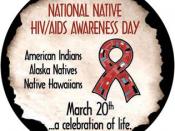Introduction:
AIDS - acquired immune deficiency syndrome - was first reported in the United States in 1981 and has since become a major worldwide epidemic. AIDS is caused by the human immunodeficiency virus (HIV). By killing or impairing cells of the immune system, HIV progressively destroys the body's ability to fight infections and certain cancers. Individuals diagnosed with AIDS are susceptible to life-threatening diseases called opportunistic infections, which are caused by microbes that usually do not cause illness in healthy people.
More than 600,000 cases of AIDS have been reported in the United States since 1981, and as many as 900,000 Americans may be infected with HIV. The epidemic is growing most rapidly among minority populations and is a leading killer of African-American males. According to the U.S. Centers for Disease Control and Prevention (CDC), the prevalence of AIDS is six times higher in African-Americans and three times higher among Hispanics than among whites.
Transmission of HIV is spread most commonly by sexual contact with an infected partner. The virus can enter the body through the lining of the vagina, vulva, penis, rectum or mouth during sex.
HIV also is spread through contact with infected blood. Prior to the screening of blood for evidence of HIV infection and before the introduction in 1985 of heat-treating techniques to destroy HIV in blood products, HIV was transmitted through transfusions of contaminated blood or blood components. Today, because of blood screening and heat treatment, the risk of acquiring HIV from such transfusions is extremely small.
HIV frequently is spread among injection drug users by the sharing of needles or syringes contaminated with minute quantities of blood of someone infected with the virus. However, transmission from patient to health-care workers or vice-versa via accidental sticks with contaminated needles or other medical instruments is rare.



Factual
rather than being an essay it's more of an report..... I'm not really sure what it was initially intended to be though
0 out of 0 people found this comment useful.